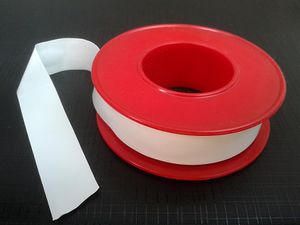Polytetrafluoroethylene
 PTFE seal tape.
| |
| Names | |
|---|---|
| IUPAC name
Poly(1,1,2,2-tetrafluoroethylene)
| |
| Other names
Fluon
Poly(tetrafluoroethene) Poly(difluoromethylene) Poly(tetrafluoroethylene) PTFE Syncolon Teflon | |
| Properties | |
| (C2F4)n | |
| Molar mass | 100.015·n (n=100-10,000) |
| Appearance | White slippery solid |
| Odor | Odorless |
| Density | 2.200 g/cm3 |
| Melting point | 327 °C (621 °F; 600 K) (displays decomposition) |
| Boiling point | Decomposes |
| Insoluble | |
| Solubility | Insoluble in all solvents |
| Vapor pressure | ~0 mmHg |
| Hazards | |
| Safety data sheet | SpectrumChemical |
| Except where otherwise noted, data are given for materials in their standard state (at 25 °C [77 °F], 100 kPa). | |
| Infobox references | |
Polytetrafluoroethylene or PTFE or Teflon is a synthetic fluoropolymer of tetrafluoroethylene, well known for its chemical inertness and very low coefficient of friction.
Contents
[hide]Properties
Chemical
PTFE is extremely resistant to chemical attacks, being only affected by molten alkali and strong fluorinating agents such as cobalt(III) fluoride and xenon difluoride. Teflon strips appear to burn in air, but it's most likely that the pyrolysis products are the one that catch fire. It will however enter a reaction that resembles burning when mixed with magnesium powder; see below on the mechanism of this reaction.
High temperatures cause PTFE to decompose into lower perfluorocarbons, some of which are very toxic. Reactions with moisture in the air also cause a small amount of HF to form.
Very high temperatures cause PTFE to liberate elemental fluorine, which makes it useful as an oxidizer for flash powders, in which the fluorine immediately and very energetically reacts with a metal such as aluminium or magnesium. The burning of metals in hot fluorine produces enormous heat which is used to decompose more PTFE, causing a chain reaction. This reaction may also be useful as a relatively safe method of fluorinating various substances which normally require the extremely dangerous fluorine gas to fluorinate.
Physical
PTFE is a white solid at room temperature, with a melting point of 327 °C. Its density is 2.2 g/cm3. PTFE maintains mechanical properties down to temperatures of 5 K (−268.15 °C), and has good flexibility at temperatures above −79 °C. Teflon materials however have poor mechanical properties and are susceptible to creep. When melted, PTFE has the consistency of paste which slowly decomposes, so items can only be cast via injection or made via machining blocks of PTFE.
Availability
PTFE is cheaply available as thread seal tapes. Many lab items, such as stoppers, gaskets, sleeves, magnetic stirrers are made from Teflon and can be easily procured online. However, items made of PTFE are expensive, as PTFE cannot be worked like the more common type of plastics.
Most frying pans also contain PTFE, but it's impractical to extract it or to use it for anything else.
Lab items made of PTFE
- Entirely made of PTFE: beaker, tube connector, crucible, crystallizing dish, dropping bottle, Erlenmeyer flask, evaporating dish, filter membrane, funnel, joint sleeve (flexible and rigid), mechanical stirrer adapter, reaction vessel, reagent bottle, round-bottom flask, sampler/ladle, scoop, stirring rod, stopcock, stopper, test tube (with screw lid), test tube rack, thermometer adapter, tissue grinder, tubing, watch glass, etc.
- PTFE coated: flexible bellows, keck clip, mechanical stirrer, spatula, stir bar, stir bar retriever, tweezers, etc.
- Containing parts made of PTFE: digestion tube, powder addition funnel, anything with a PTFE stopcock, etc.
Preparation
PTFE is made via polymerization of tetrafluoroethylene. This process is nigh-impossible for the amateur chemist to perform due to the high reactivity of tetrafluoroethylene and difficulty of producing this compound from scratch.
Projects
- Container for hydrofluoric acid (PTFE beakers and bottles)
- Magnesium/PTFE flash powder
- Ytterbium/PTFE emerald green composition with high IR output
Handling
Safety
PTFE, being chemically inert, is non-toxic. Its pyrolysis is detectable at 200 °C, giving off fluorocarbon gases, that in large quantities can be dangerous for humans and are very toxic to wildlife, such as birds.
Storage
No special storage is required.
Disposal
Teflon materials can be safely dumped in the trash.
Being chemically inert, PTFE poses hazard to the environment, as it cannot be digested by wildlife.


